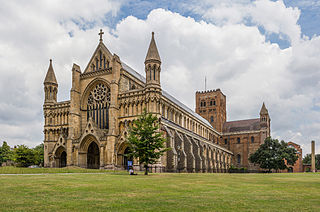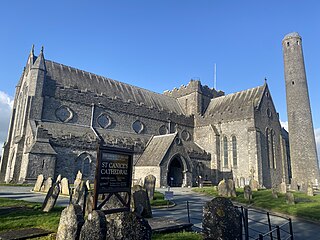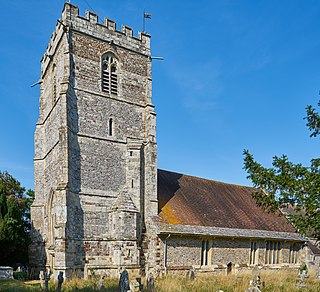
Romanesque architecture is an architectural style of medieval Europe that was predominant in the 11th and 12th centuries. The style eventually developed into the Gothic style with the shape of the arches providing a simple distinction: the Romanesque is characterized by semicircular arches, while the Gothic is marked by the pointed arches. The Romanesque emerged nearly simultaneously in multiple countries ; its examples can be found across the continent, making it the first pan-European architectural style since Imperial Roman architecture. Similarly to Gothic, the name of the style was transferred onto the contemporary Romanesque art.

St Albans Cathedral, officially the Cathedral and Abbey Church of St Alban, also known as "the Abbey", is a Church of England cathedral in St Albans, England.

Sherborne Abbey, otherwise the Abbey Church of St. Mary the Virgin, is a Church of England church in Sherborne in the English county of Dorset. It has been a Saxon cathedral (705–1075), a Benedictine abbey church (998–1539), and since 1539, a parish church.

Malmesbury Abbey, at Malmesbury in Wiltshire, England, is a former Benedictine abbey dedicated to Saint Peter and Saint Paul. It was one of the few English religious houses with a continuous history from the 7th century through to the Dissolution of the Monasteries.

Anglo-Saxon architecture was a period in the history of architecture in England from the mid-5th century until the Norman Conquest of 1066. Anglo-Saxon secular buildings in Britain were generally simple, constructed mainly using timber with thatch for roofing. No universally accepted example survives above ground. Generally preferring not to settle within the old Roman cities, the Anglo-Saxons built small towns near their centres of agriculture, at fords in rivers or sited to serve as ports. In each town, a main hall was in the centre, provided with a central hearth.

Dunbrody Abbey is a former Cistercian monastery in County Wexford, Ireland. The cross-shaped church was built in the 13th century, and the tower was added in the 15th century. With a length of 59m the church was one of the longest in Ireland. The visitor centre is run by the current Marquess of Donegall and has one of only two full sized hedge mazes in Ireland.

Ferns is a historic town in north County Wexford, Ireland. It is 11 km (7 mi) north of Enniscorthy. The remains of Ferns Castle are in the centre of the town. The town is in a civil parish of the same name.

The term Norman architecture is used to categorise styles of Romanesque architecture developed by the Normans in the various lands under their dominion or influence in the 11th and 12th centuries. In particular the term is traditionally used for English Romanesque architecture. The Normans introduced large numbers of castles and fortifications including Norman keeps, and at the same time monasteries, abbeys, churches and cathedrals, in a style characterised by the usual Romanesque rounded arches and especially massive proportions compared to other regional variations of the style.

Christ Church Greyfriars, also known as Christ Church Newgate Street, was a church in Newgate Street, opposite St Paul's Cathedral in the City of London. Established as a monastic church in the thirteenth century, it became a parish church after the Dissolution of the Monasteries. Following its destruction in the Great Fire of London of 1666, it was rebuilt to the designs of Sir Christopher Wren. Except for the tower, the church was largely destroyed by bombing during the Second World War. The decision was made not to rebuild the church; the ruins are now a public garden.

St Nicholas Church is a Church of England parish church in Kenilworth, Warwickshire, England.

Malton Priory, Old Malton, North Yorkshire, England, is near to the town of Malton. It was founded as a monastery of the Gilbertine Order by Eustace fitz John, the lord of Malton Castle. Fitz John founded both Malton Priory and Watton Priory around 1150; some sources suggest that this was an act of penance for his support for the Scots in the Battle of the Standard.

St Mary's Priory Church, Deerhurst, is the Church of England parish church of Deerhurst, Gloucestershire, England. Much of the church is Anglo-Saxon. It was built in the 8th century, when Deerhurst was part of the Anglo-Saxon kingdom of Mercia. It is contemporary with the Carolingian Renaissance on mainland Europe, which may have influenced it.

St Peter's Church is the parish church of Prestbury, Cheshire, England. It is probably the fourth church on the site. The third, the Norman Chapel, stands in the churchyard. The church is recorded in the National Heritage List for England as a designated Grade I listed building. The Norman Chapel, the lychgate and west wall, the Hearse House, and the sundial in the churchyard are listed at Grade II. It is a Church of England parish church in the diocese of Chester, the archdeaconry of Macclesfield, and the deanery of Macclesfield.

St Leonard's Church is in Sandridge, a village in Hertfordshire, England. It is an active Anglican parish church. The building is Grade II* listed: notable features include its chancel arch made from recycled Roman brick.

St Canice's Cathedral, also known as Kilkenny Cathedral, is a cathedral of the Church of Ireland in Kilkenny city, Ireland. It is in the ecclesiastical province of Dublin. Previously the cathedral of the Diocese of Ossory, it is now one of six cathedrals in the United Dioceses of Cashel and Ossory.

Kildare Cathedral, or St Brigid's Cathedral in Kildare, is one of two Church of Ireland cathedrals in the United Dioceses of Meath and Kildare. It is in the ecclesiastical province of Dublin. Originally a Catholic cathedral, it was built in the 13th century on the site of an important Celtic Christian abbey, which is said to have been founded by Saint Brigid in the 5th century. The site was taken over by the Protestant Church of Ireland following the Reformation. There is an Irish round tower in the cathedral grounds.

Cranborne Priory is a former priory church in the village of Cranborne, Dorset, England. Founded in 980 as Cranborne Abbey, it became a priory in 1102, remaining that way until it was dissolved in 1540. The tower, nave and aisles from the priory survive to form the Church of St Mary and St Bartholomew, the parish church of Cranborne. The building, which has fragments from the 12th century, is designated a Grade I listed building.

St. Mary's Abbey in Trim, County Meath, Ireland is a former house of Augustinian canons dedicated to the Blessed Virgin. The abbey was situated on the north bank of the River Boyne, opposite Trim Castle, on land given to St. Patrick who is often credited with founding the abbey. The abbey was a prominent pilgrimage site, famous for the healing power of its statue of the Virgin Mary, until its dissolution under Henry VIII during the Reformation. Little remains of the abbey except for the Yellow Steeple, the ruin of the abbey bell tower named for the yellow color reflected by the stonework in the setting sun, and Talbot's Castle, an abbey building converted to a manor house.

Skryne Church is a ruined medieval church and National Monument in County Meath, Ireland.




















